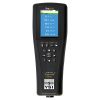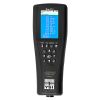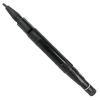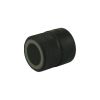YSI ODO/T Probe & Cable Assemblies
Features
- One–cable design for easy dissolved oxygen measurements in the field and at deep depths
- Rugged probe and cable designed for field work with 2-year warranty
- Sensors store calibration data, so probe assemblies can be swapped between handhelds without the need for re-calibration
- Free ground shipping
- Expedited repair and warranty service
- Lifetime technical support
- More
Overall
The YSI ODO/T probe assembly pairs with the ProSolo Handheld to form a complete sampling system. Featuring integral, digital sensors, the ODO/T is plug-and-play which minimizes time spent on instrument setup. ProDIGITAL technology allows the handheld to automatically recognize connected sensors, so there is no need to tell the instrument what is connected.
Non-Consumptive Technology
The YSI ODO/T probe's technology is non-consumptive, meaning oxygen is not consumed during the measurement. Flow dependence is non-existent, and no stirring is required. The ODO sensor is not susceptible to interferences from other gases, drifts less and holds calibration longer than membrane-covered sensors. Maintenance is a breeze with a simple, threaded optical cap that is good for at least two years.
ProDIGITAL ODO/T Benefits
- Integral optical dissolved oxygen, and temperature sensors that are auto-recognized by Pro DIGITAL handhelds, reducing instrument set-up time
- Rugged Optical DO sensor cap with a 2-year warranty is pre-installed on new assemblies
- Military Spec (MS) connector and a weighted, stainless steel probe guard
- Fits in a 1-inch well with cable lengths up to 100 meters
- 2-year warranty on cable, sensors, and ODO cap
In The News
Floating Global New Ideas: Buoy-Enabled Research at Florida Agricultural and Mechanical University’s School of the Environment
Florida Agricultural and Mechanical University (FAMU), based in Tallahassee, Florida, is the highest-rated public Historically Black College or University in the United States. FAMU’s School of the Environment (FAMU-SOE) offers BS and BA degrees in Environmental Studies, and BS, MS, and Ph.D. degrees in Environmental Science, with specialisms available in areas including Environmental Policy and Risk Management, Aquatic and Terrestrial Ecology, and Biomolecular Sciences. In 2021, FAMU-SOE deployed a NexSens CB-450 buoy in Apalachee Bay, a key oyster farming area around 30 miles south of Tallahassee. The buoy has quickly been incorporated into the curriculum, providing environmental insights for student research, the community, and beyond. Dr.
Read MoreMonitoring Habitat Suitability and Water Quality in Northwest Arkansas Springs
Northwest Arkansas has seen an economic, industrial, and population boom in recent years as a result of expanding businesses, which have created thousands of jobs in the region and the mass migration of employees and construction companies. However, with this growth has come rapid urbanization and the degradation of the natural landscape, specifically the freshwater springs that can be found throughout the region. These springs are critical habitat centers for native wildlife, home to threatened and endangered fish, and those that have yet to be listed. Zach Moran, Assistant Professor of Fisheries Science at Arkansas Technical University, is working to help monitor these habitats and provide key data that will hopefully inform future development in the region.
Read MoreThree Decades of Research at Acton Lake
A multi-disciplinary team at Miami University, Ohio, has been studying the environmental change at Acton Lake for over three decades. Using three different NexSens buoys over this time, the team has an incredible archive of data that is helping build a picture of Acton’s past, present, and future. Until recently, a NexSens CB-50 buoy was used alongside other environmental monitoring at Acton Lake. In May 2025, the Miami team deployed a new XB-200 buoy , future-proofing their ongoing monitoring using real-time buoy systems. Acton Lake, a small hypereutrophic reservoir in southwest Ohio, covers 2.4km² and has a maximum depth of about 8m. The dam was built in 1956, and the lake has a large agricultural watershed.
Read More




















